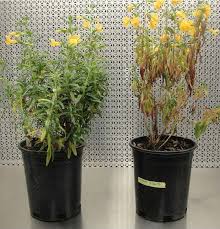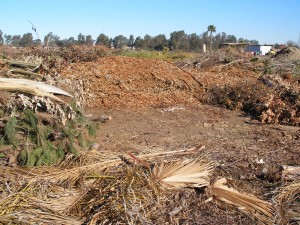sticky monkey flower – plant on right is infested by P. tentaculata; photo by Suzanne Rooney-Latham, California Department of Food & Agriculture
In April, I posted a blog reporting on a study in Europe that documented 64 Phytophthora taxa detected in woody plant nurseries or forest restoration plantings. The presence of Phytophthora was widespread, if not universal: 91% of the 732 nurseries analyzed and 66% of forest and landscape plantings had at least one Phytophthora taxon present.
The risk of serious disease in native European plants appears to be substantial: one or more of 19 Phytophthora species which can attack native European or widely-planted trees and shubs were isolated from 84% of ornamental planted stands. Hundreds of previously unknown Phytophthora–host associations were observed.
These percentages could be underestimates, because detection of Phytophthora infestation is difficult. One of the principal difficiulties is that the majority of infested plants in nurseries did not display symptoms.
How does the situation in Europe compare to that that in the United States? We don’t know, because no-one has carried out a similarly wide-ranging, nation-wide study. However, some partial studies indicate reason for concern.
Knaus et al. 2015 summarized their own findings from Oregon and those of earlier state-by-state studies:
- Knaus and colleagues surveyed symptomatic Rhododendron in seven nurseries in Oregon and found evidence of widespread infestation. P. syringae was found in all seven nurseries; P. plurivora in six. Nine other taxa were found in one or a few nurseries. Which Phytophthora species were present varied greatly across nurseries and – within individual nurseries – by season (spring or fall).
- Surveys by Schwingle and colleagues of 45 nurseries in Minnesota in 2002-2003 and fewer nurseries in 2004 and 2005 found five Phytophthora species.
- A survey by Warfield and colleagues of 14 North Carolina nurseries in 2003 found three Phytophthora species.
- Donohue and Lamour surveyed 29 Tennessee nurseries in 2004-2005; they found seven Phytophthora species.
- A survey of 1,619 California nurseries in 2005 and 2006 carried out by Yakabe and colleagues found eight Phytophthora species (but see below).
- A survey of 10 Maryland nurseries by Bienapfl and Balci in 2010-2012 found 10 Phytophthora species; six of these were on plants that had arrived recently from West Coast suppliers.
- A set of repeated surveys of four Oregon nurseries in 2006 – 2009 by Parke and colleagues found 16 Phytophthora species on rhododendron tissues (most of studies looked only at lesions on leaves)
All these studies found the P. citricola complex to be the most widespread. In West Coast nurseries, P. syringae was common.
Knaus et al. conclude that since there is a great amount of heterogeneity among Oregon nurseries, it is likely that, as more nurseries are surveyed, a greater amount of Phytophthora diversity may be discovered within nurseries.
Most of the surveys reported by Knaus and colleagues were done in response to detection of the sudden oak death pathogen (SOD), P. ramorum, on plants shipped from California and Oregon in the interstate plant trade. Since funding for tracking P. ramorum and other Phytophthora species in nursery stock has fallen considerably (see below), it is unlikely that such surveys will be repeated or expanded to other states – despite the apparent widespread presence of these actual or potential pathogens.
Crisis in Native Plant Nurseries in California – What Does it Mean for Other States?
California has discovered the widespread presence of Phytophthora in native plants used to restore native habitats after disturbance, e.g., construction of water or other projects. These pathogens were traced to native plant nurseries. Nursery stock had been planted before the infestation problem was realized – so restoration managers are now trying to clean up both the nurseries and the restoration sites. This situation was discussed during a special session of the 6th SOD Science Symposium in San Francisco in June 2016. More than 170 people attended the session – demonstrating a high level of concern in the native plant community. Abstracts and presentations will be available at http://ucanr.edu/sites/sod6/.
The problem was first discovered in 2012 when a nursery noted severe dieback of sticky monkey flower (Diplacus (Mimulus) aurantiacus). The California Department of Food and Agriculture (CDFA) identified the cause as P. tentaculata – which is a federally-designated “quarantine pest”. It had never before been detected in the United States.
Native plant nursery owners and restoration ecologists responded quickly by sending many samples for identification. Between January 2014 and June 2016, CDFA evaluated 1,500 samples from nurseries and field sites. One quarter of the samples were positive for at least one Phytophthora species. In total, 25 species were detected, although 70% of the samples belonged to one of six taxa.
Little is known about root pathogens of California’s native plants. The sample results revealed a long list of newly detected associations. However, it has also proved especially difficult to detect symptoms on some plants. Finally, since only symptomatic plants were sampled, it is likely that additional plant-Phytophthora associations remain to be detected.
No one knows which plant-Phytophthora associations are capable of creating epidemics of plant disease. At least two species have raised particular concern:
- P. tenticulata. This causes root and stem rot on a wide variety of plants, including several in the Asteraceae and Lamiaceae – two large, widespread, and horticulturally significant plant families. See http://www.suddenoakdeath.org/wp-content/uploads/2015/02/P.tentaculata.Pest_.Alert_.022315.pdf ); and
- quercina. This pathogen is aggressive on all of Europe’s oak trees. It is also a federal quarantine pest.
Among the “lessons learned” are two previously identified following the detection of P. ramorum in horticultural nurseries a decade earlier and reinforced now:
- artificial irrigation of plants in nurseries facilitates infestations and movement of infested plant material; and
- re-use of infested pots facilitates spread of these infestations.
Therefore, both nursery managers and regulators need to be alert to this risk in all types of nurseries. The necessary changes in nursery practices will take time. See the talk by Alisa Shor from the Parks Conservancy, which operates the nursery for the Golden Gate National Recreation Area when the meeting presentations are posted at http://ucanr.edu/sites/sod6/. Shor described the extensive efforts made by Parks Conservancy nurseries to clean up and adopt new procedures.
Agencies responsible for restoration projects face a daunting task. They have found dozens of Phytophthora taxa at already-planted sites, including the two identified above as federal quarantine species. Managers must develop best management practices that apply to contract specifications for equipment and workers operating on those sites; for nurseries wishing to bid to supply plants; and for planting protocols. Meanwhile, existing restoration regulations require them to restore plant cover quickly – which cannot be done by relying on seed – which is less likely to harbor a pathogen than the containerized plants now used.
As noted above, the high-risk nursery practices identified in this case match those identified over the past decade in response to the spread of sudden oak death (SOD) through nursery stock. Ted Sweicki, an ecologist long engaged on SOD and related issues and now advising the restoration agencies, noted that it is easier to prevent introduction of a Phytophthora to a site then to clean up the site afterwards. He advocated adoption of systems approach to mitigate Phytophthora presence in nurseries. Ted said this is not a new idea! However, adoption of such practices has been far too slow in the horticultural trade. Ted was hopeful that this new crisis in California would have a different result because:
- Owners of native plant nurseries are strongly concerned about the environment;
- Restoration agencies are averse to being responsible for introduction of Phytophthora species to their lands; and
- These agencies make purchases that are sufficiently large to empower the agencies to compel nurseries to comply with strict protocols.
People in other states should not rest easy. There is no reason to think this problem is limited to California. Other states need to be looking at the diversity of Phytophthora species in their nurseries and plantings. But are they doing so?
Meanwhile, federal funds that have supported studies of the genetics of P. ramorum in both West Coast forests and in nurseries are rapidly disappearing. The information provided by these studies has been crucial to tracing movement of various strains of the pathogen.
As noted in my earlier blog, none of the 59 Phytophthora taxa thought to be alien in Europe had been intercepted at European ports of entry. In the U.S., it has not been determined how the P. tentaculata detected in 2012 was introduced. Authorities suspect it was introduced on plant imports.
These situations reinforce the importance of APHIS promptly finalizing its 2013 proposed revision to regulations governing imported plants [http://federalregister.gov/a/2013-09737]. The proposed rule would establish APHIS’ authority to require foreign plant suppliers to adopt “critical control point”-type systems approaches to improve the cleanliness of plants intended for export to the United States. Such an approach is authorized by both a North American regional standard (RSPM#24; go here) and an international standard (ISPM#36; go here) for plant protection.
You can give APHIS a push by writing your member of Congress and Senators. Ask them to urge the Secretary of Agriculture to finalize this proposal.
As regards plants being shipped within the country, the U.S. nursery trade is working with federal and state regulators to develop and encourage adoption of similar, but voluntary, integrated systems approaches to minimize pest presence on plants being sold interstate. This proposed approach is being tested by eight nurseries across the country. However, full adoption is still years away. To learn more about the “SANC” program (“A Systems Approach to Nursery Certification”), go here.
See also http://www.suddenoakdeath.org/welcome-to-calphytos-org-phytophthoras-in-native-habitats/
SOURCES
Jung, T. et al. 2015 “Widespread Phytophthora infestations in European nurseries put forest, semi-natural and horticultural ecosystems at high risk of Phytophthora disease” Forest Pathology. November 2015; available from Resource Gate
Knaus, B.J., V.J. Fieland, N.J. Grunwald. 2015. Diversity of Foliar Phytophthora Species on Rhododendron in Oregon Nurseries. Plant Disease Vol 99, No. 10 326 – 1332
Posted by Faith Campbell

 willow tree in Tijuana River riparian area felled by KSHB. Photo by John Boland; used by permission
willow tree in Tijuana River riparian area felled by KSHB. Photo by John Boland; used by permission